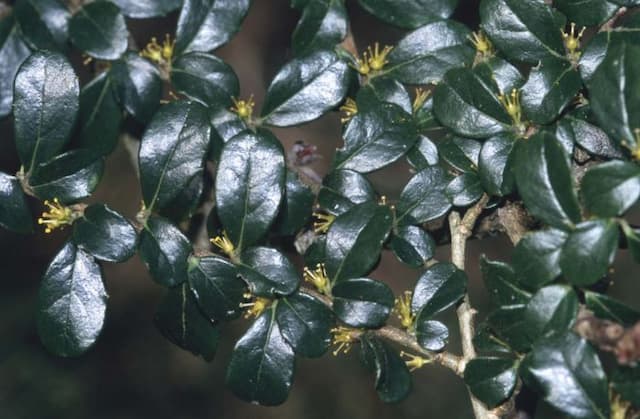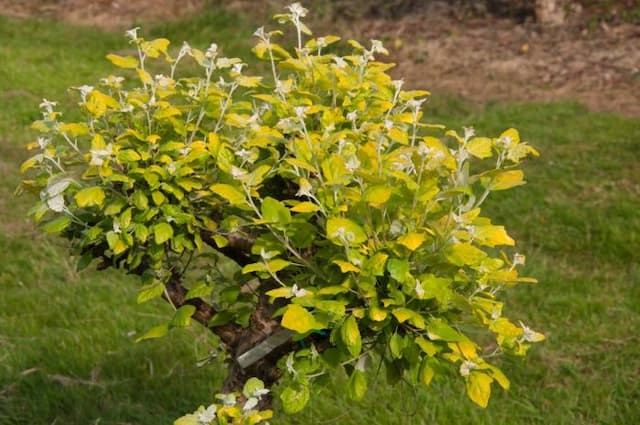Lombardy Poplar Populus nigra 'Italica' (m)

ABOUT
The Lombardy poplar is characterized by its distinctively narrow, columnar shape which gives it a unique, upright appearance. Its dense branches grow upwards closely, forming a slender silhouette. During the growing season, its leaves are a vibrant green, with a glossy texture on the upper surface and a more muted, paler shade beneath. These leaves are generally triangular with serrated edges and are attached to the branches by long, flattened stalks that cause them to flutter in the wind, creating a rustling sound. As the seasons transition to autumn, the foliage transforms into eye-catching yellow hues before shedding. The bark of the Lombardy poplar is grey-brown and deeply furrowed, adding a textural component to the landscape. Although commonly planted in rows for screening or to create visual interest with their pronounced verticality, they are versatile enough to be solitary specimens in the landscape.
About this plant
 Names
NamesFamily
Salicaceae
Synonyms
Lombardy Poplar, Italian Poplar
Common names
Populus italica, Populus nigra var. italica, Populus nigra var. pyramidalis, Populus pyramidalis.
 Toxicity
ToxicityTo humans
The most common name for Populus nigra 'Italica' is the Lombardy poplar. The Lombardy poplar is generally not considered toxic to humans. There is no widespread evidence of poisoning or severe adverse health effects from ingesting parts of this tree. However, as with many plants, individual sensitivities or allergic reactions are possible. Therefore, ingesting any plant material should be done with caution and knowledge about its edibility and potential effects.
To pets
The Lombardy poplar is not known to be toxic to pets. There is no significant data indicating that pets, such as dogs and cats, experience poisoning from ingesting parts of this tree. However, non-toxic plants can still cause gastrointestinal upset if ingested in large quantities or if a pet has a particular sensitivity to the plant. It's always best to prevent pets from ingesting plant material unless it is known to be safe for them.
 Characteristics
CharacteristicsLife cycle
Perennials
Foliage type
Deciduous
Color of leaves
Green
Height
50-70 feet (15-21 meters)
Spread
10-15 feet (3-4.5 meters)
Plant type
Tree
Hardiness zones
4-9
Native area
Europe
Benefits
 General Benefits
General Benefits- Shade provider: Populus nigra 'Italica', commonly known as the Lombardy poplar, creates a significant amount of shade due to its dense foliage and upright growth habit.
- Windbreak: The fast growth and tall, columnar form of the Lombardy poplar make it an effective windbreak, protecting buildings and smaller plants from strong winds.
- Erosion control: The robust and extensive root system helps stabilize soil and prevent erosion, particularly along streams and waterways.
- Landscape design: Its vertical accent and dramatic appearance are utilized in landscape design to create visual interest and backdrop for other plants.
- Privacy screen: When planted in rows, the Lombardy poplar serves as a natural privacy screen due to its height and growth pattern.
- Noise reduction: The dense foliage can help to muffle sounds, reducing noise pollution in urban and suburban settings.
- Habitat provision: Provides shelter and nesting sites for birds and other wildlife due to its height and branch structure.
- Seasonal interest: Exhibits seasonal changes, from the bright green spring foliage to the golden yellow colors in autumn, adding to the aesthetic appeal of an area.
 Medical Properties
Medical Properties- Anti-inflammatory: Extracts from the buds of Populus nigra 'Italica', commonly known as the Lombardy poplar, have been traditionally used for their anti-inflammatory properties.
- Analgesic: The plant has been used to relieve pain due to its salicin content which is chemically related to aspirin.
- Antiseptic: Balsamic resins found in the buds of Lombardy poplar are traditionally used for their antiseptic qualities.
- Expectorant: The plant contains compounds that are believed to help in expelling phlegm from the respiratory tract.
- Diuretic: The leaves and bark of the Lombardy poplar have been used to promote urination and relieve water retention.
 Air-purifying Qualities
Air-purifying QualitiesThis plant is not specifically known for air purifying qualities.
 Other Uses
Other Uses- Windbreaks: The Lombardy poplar is often used as a windbreak in agricultural settings, shielding crops and soil from harsh winds due to its tall and fast-growing nature.
- Noise Barrier: Owing to its dense growth, the Lombardy poplar can be an effective noise barrier, helping to reduce traffic noise when planted in rows along highways.
- Privacy Screening: Their tall and narrow growth habit makes these trees an excellent choice for privacy hedges or screens in urban and suburban landscapes.
- Erosion Control: The extensive root system of the Lombardy poplar can help stabilize soil and prevent erosion, especially along riverbanks and areas with loose soil.
- Landscape Vertical Accent: Due to their unique columnar form, Lombardy poplars are used to create dramatic vertical accents in landscape design, adding height and structure to gardens.
- Soil Improvement: As a fast-growing species, the Lombardy poplar can be used in phytoremediation to improve soil quality in contaminated areas by absorbing pollutants.
- Shelter for Wildlife: Lined up in rows, these trees can provide shelter and nesting sites for birds while acting as a corridor for other wildlife.
- Traditional Craft Material: The wood of the Lombardy poplar is sometimes used in traditional crafts, such as basket weaving, due to its flexibility when young.
- Habitat Creation: When planted near aquatic environments, Lombardy poplars can enhance the habitat by providing shade and cooler areas for fish and other aquatic species.
- Seasonal Interest: The Lombardy poplar is planted for its seasonal interest, with bright green leaves in spring and summer that turn golden yellow before shedding in the fall.
Interesting Facts
 Feng Shui
Feng ShuiThe Lombardy poplar is not used in Feng Shui practice.
 Zodiac Sign Compitability
Zodiac Sign CompitabilityThe Lombardy poplar is not used in astrology practice.
 Plant Symbolism
Plant Symbolism- Growth - Lombardy Poplar's fast growth rate symbolizes the rapid progress and development in one's life.
- Resilience - The hardy nature of the Lombardy Poplar represents strength and the ability to withstand life's challenges.
- Victory - In some cultures, poplar leaves were given to winners of sporting events, symbolizing triumph and success.
- Elevation - With its tall and narrow shape, the Lombardy Poplar stands for reaching towards the heavens and aspiring towards greater heights.
- Protection - Historically, these trees were often planted as windbreaks, thus they've come to symbolize shelter and protection from adversity.
 Water
WaterLombardy poplar trees require regular watering, especially during the first few growing seasons to establish a deep, extensive root system. Water young trees weekly or more often in extreme heat, applying 15 to 20 gallons per watering session. Once established, they are relatively drought-tolerant and may require less frequent watering, dependent on weather conditions. During dry spells, provide a deep watering every two to three weeks. Always ensure the soil around the poplar is moist but not waterlogged, as excess water can lead to root rot.
 Light
LightLombardy poplars thrive in full sun, meaning they require at least six hours of direct, unfiltered sunlight each day. The best spot for planting a Lombardy poplar is an open area where the tree can receive ample sunlight from above without being shaded by other trees or structures.
 Temperature
TemperatureLombardy poplars are hardy and can tolerate a wide temperature range; they can survive winter temperatures as low as -30°F and can handle summer temperatures well above 100°F. The ideal growing conditions for Lombardy poplars is in a region where the temperature stays within 50°F to 75°F.
 Pruning
PruningLombardy poplars should be pruned to remove dead or damaged branches, to shape the tree, and to prevent potential hazards as they can grow quite large. Pruning should be done in the winter months when the tree is dormant. It's generally recommended to prune the tree every three to five years, but this can vary depending on the tree's health and specific growth pattern.
 Cleaning
CleaningNot needed
 Soil
SoilThe Lombardy Poplar prefers deep, fertile, and well-draining soil. A blend of loamy soil with compost and peat moss works best, ensuring adequate nutrients and moisture retention. This tree is adaptable to a range of soil pH levels from slightly acidic to slightly alkaline (pH 5.0 to 8.2).
 Repotting
RepottingAs the Lombardy Poplar is a large, fast-growing tree, repotting is not applicable. Instead, it is planted in a permanent outdoor location where it has ample room to grow.
 Humidity & Misting
Humidity & MistingLombardy Poplar trees are quite adaptable and do not require specific humidity conditions. They can thrive in the ambient outdoor humidity levels across a wide range of climates.
 Suitable locations
Suitable locationsIndoor
✖ Lombardy Poplar is not suitable for indoor growth due to size.
Outdoor
Plant in full sun, well-draining soil, space for growth.
Hardiness zone
4-9 USDA
 Life cycle
Life cyclePopulus nigra 'Italica', commonly known as the Lombardy poplar, begins its life cycle when seeds, dispersed by wind or water, land in suitable soil and germinate. The seedlings rapidly grow into juvenile trees, with growth rates that can exceed 2 meters per year under ideal conditions. The Lombardy poplar reaches maturity in as little as 10 years, whereupon it begins to produce flowers; being dioecious, the male (m) trees produce pollen that is carried by wind to fertilize female trees. After pollination, female trees set seeds while male trees drop their pollen-bearing catkins, completing the reproductive cycle. Mature trees can live for 40 to 150 years, but are often shorter-lived in urban or landscape settings due to susceptibility to diseases and pests. The end of the Lombardy poplar’s life cycle is reached when the tree dies and decomposes, returning nutrients to the soil and potentially providing a substrate for new seedlings.
 Propogation
PropogationPropogation time
Early Spring
The Lombardy Poplar, scientifically known as Populus nigra 'Italica', is most commonly propagated through hardwood cuttings. This method typically takes place during the dormant season, particularly in late winter before new growth begins. To propagate by this method, one takes a section of a dormant branch, usually around 8 to 10 inches (20 to 25 cm) long and about 1/2 to 3/4 inch (1.3 to 1.9 cm) in diameter. The cuttings are then inserted into soil so that a few buds are above the surface. The soil should be kept moist to encourage rooting. Roots usually develop through the winter and early spring, so that by the planting season, the new saplings are ready to be transplanted into their permanent locations. This method of propagation is simple and effective, making it the most popular for replicating the Lombardy Poplar.









